Imagine stepping into a world where every fleeting expression tells a story—a story of customer delight, hidden dissatisfaction, or even the silent stress of an overworked team member.
In a fast-paced business landscape, understanding these nuanced signals can be the difference between soaring success and missed opportunities.
AI emotion recognition is at the forefront of this transformation, turning the abstract art of reading human emotions into a precise, data-driven science.
Picture a bustling retail environment where digital displays, informed by real-time emotion analysis, adapt instantly to the mood of shoppers. A subtle smile or a puzzled look isn’t just an expression—it’s valuable feedback that can reshape in-store experiences and refine marketing strategies on the fly.
This technology is already helping large retailers adjust store layouts, refine promotional offers, and even curate personalized shopping experiences, demonstrating that the future of customer engagement is as much about emotion as it is about efficiency.
But the impact of AI emotion recognition doesn’t stop at the storefront. In manufacturing, where worker safety and productivity are paramount, emotion detection tools are being used to monitor stress and fatigue in real-time.
By identifying early signs of burnout or distraction, companies can intervene before these issues translate into costly errors or safety incidents. In distribution, understanding the sentiment of both customers and logistics partners can lead to smarter supply chain decisions, reducing delays and optimizing operational flow.
This article will take you on a journey through the transformative power of emotion recognition technology. We’ll explore how its application in retail, manufacturing, and distribution isn’t just a technological upgrade—it’s a strategic investment in understanding the human element behind every business process.
With real-world scenarios and practical insights, we’ll show how decoding emotions can lead to hyper-personalized customer experiences, enhanced workforce well-being, and smarter, more agile operations.
Ready to discover how tapping into the subtle language of emotions can unlock unprecedented business growth? Let’s dive in.
What is AI emotion recognition and how does it work?
At its core, AI emotion recognition is a sophisticated branch of artificial intelligence that deciphers the subtle language of human expressions. This technology harnesses advanced algorithms to analyze visual cues, vocal modulations, and even textual nuances to determine a person's emotional state.
Imagine a system that not only sees a fleeting smile or a hint of confusion but understands these signals with impressive accuracy.
This is made possible through a combination of emotion recognition technology, machine learning emotion detection, and AI facial emotion recognition.
These components work together to transform raw data into actionable insights.
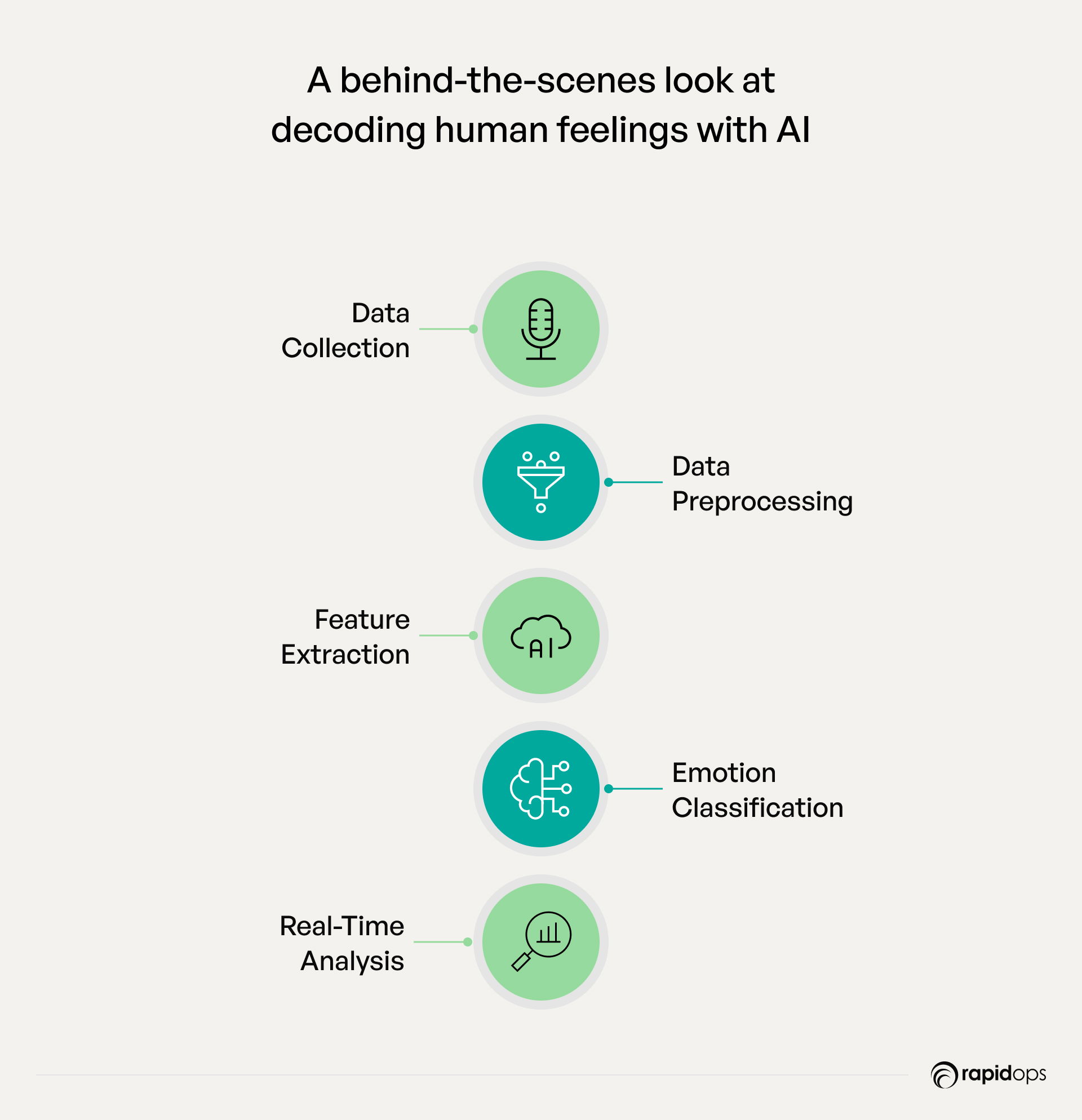
How AI emotion recognition works
- Data collection: The process begins by capturing data through various channels—cameras for facial expressions, microphones for tone variations, and text inputs from customer feedback or social media interactions.
- Data preprocessing: This raw data is then cleaned and standardized to remove noise, ensuring that only high-quality information is analyzed.
- Feature extraction: Here, the system identifies key features such as micro-expressions, shifts in voice tone, or specific word patterns that are indicative of underlying emotions.
- Classification: Advanced machine learning models, trained on diverse datasets, then classify these features into recognizable emotions like happiness, frustration, or surprise. This is where machine learning emotion detection truly shines.
- Real-time analysis: The interpreted data is processed into actionable insights, often via dashboards or alerts, enabling businesses to react promptly—be it through AI-powered sentiment analysis or immediate operational adjustments.
A practical glimpse into the technology
Consider a retail scenario where digital signage adapts to the mood of its customers. As a shopper walks by, AI facial emotion recognition technology captures their expression.
If a significant number of customers display signs of confusion, the system triggers a review of the product placement or promotional messaging.
Similarly, in customer support, sentiment analysis AI can parse through live chat interactions to gauge satisfaction and prompt timely intervention when negative emotions are detected.
By decoding these subtle cues, AI emotion recognition offers a powerful tool for understanding and responding to both customer and employee sentiments.
This detailed, step-by-step approach ensures that businesses are not only aware of emotional feedback but can also act on it to drive real results.
How retail, manufacturing & distribution can use AI emotion recognition
Businesses in retail, manufacturing, and distribution are discovering that tapping into customer and employee emotions is more than a novelty—it's a strategic advantage. Here’s how each industry is leveraging AI emotion recognition to drive tangible improvements:
1. Retail: Hyper-personalized customer experience & store optimization
In retail, every customer interaction is a moment of opportunity.
By integrating AI emotion recognition in retail, businesses can transform these moments into actionable insights. Imagine a store where digital signage, music, and promotions adjust in real time based on shoppers' facial expressions and overall mood.
For example, if a display is causing confusion or disinterest, the system can immediately flag the issue for a quick redesign or a more engaging promotional strategy.
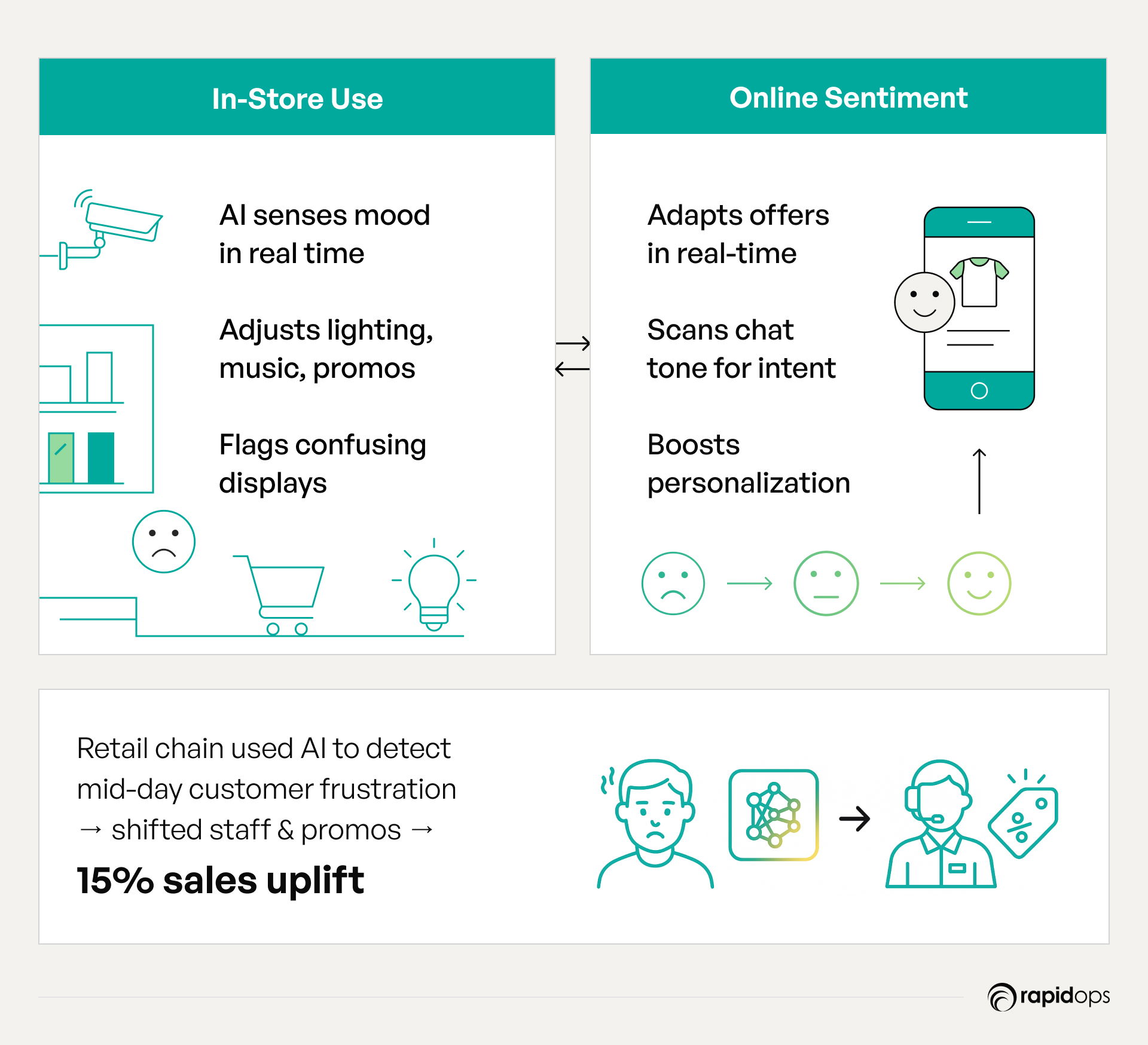
- In-store dynamics: Cameras and sensors capture subtle cues, allowing for AI-powered customer experience adjustments on the spot. This could mean altering lighting, music, or even the placement of products based on observed customer reactions.
- Online personalization: In the digital space, analyzing sentiment through live chat and social media interactions empowers retailers to tailor product recommendations and marketing messages more effectively.
Consider a scenario where a well-known retail chain implemented emotion recognition tools across its flagship stores.
They observed that during certain times of day, customer expressions indicated mild frustration—leading them to experiment with staff reallocation and targeted promotions.
The result was not only improved customer satisfaction but also an uplift in sales, proving that real-time sentiment analysis can drive immediate, measurable impact.
2. Manufacturing: Workforce productivity & quality control
In manufacturing, the human element is as critical as the machinery. AI emotion recognition helps identify worker stress, fatigue, and engagement levels, ensuring a safer and more productive environment.
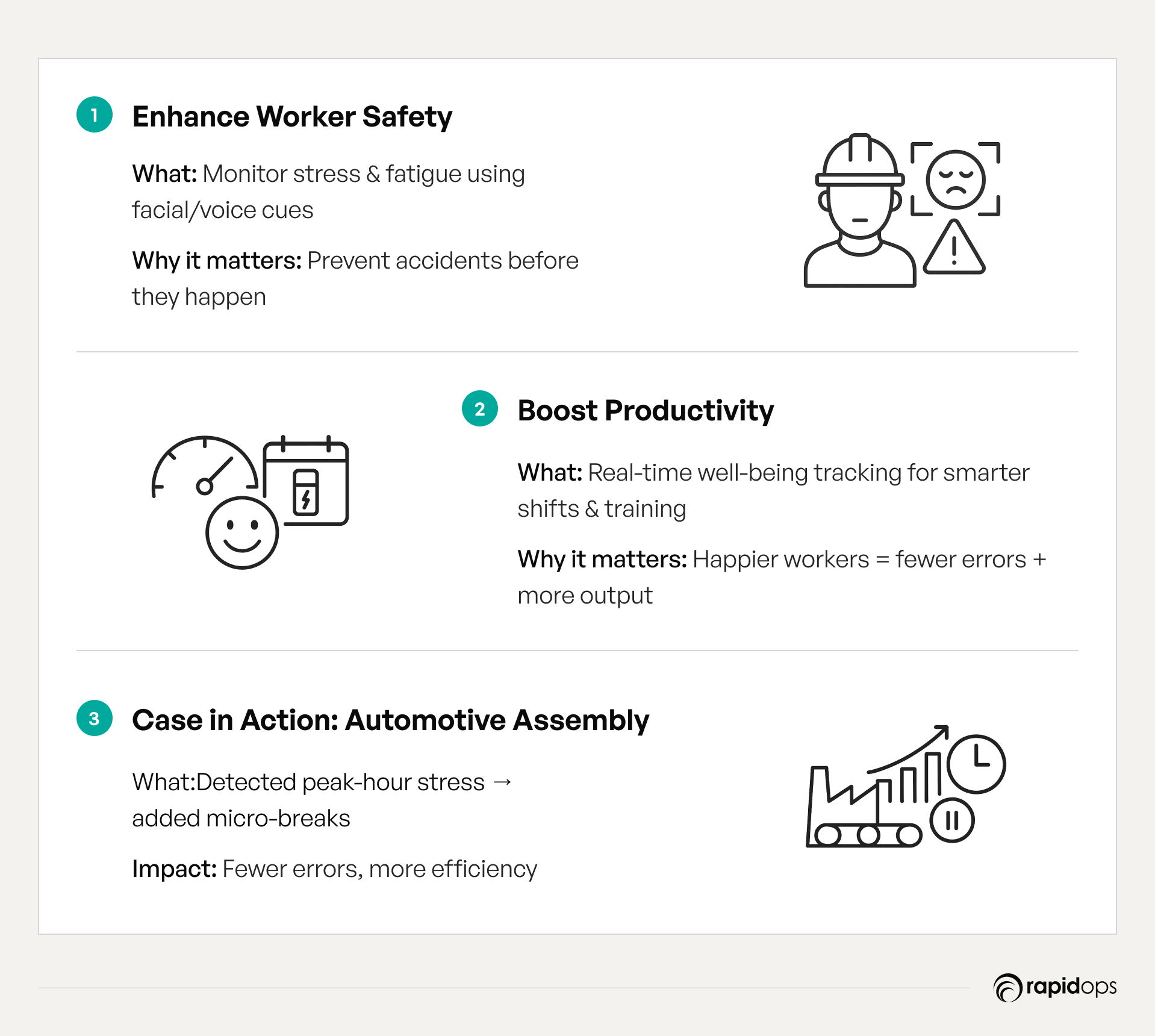 When employees are monitored for emotional cues, companies can preemptively address issues that might lead to errors or accidents on the production line.
When employees are monitored for emotional cues, companies can preemptively address issues that might lead to errors or accidents on the production line.
- Enhancing worker safety: By monitoring facial expressions and voice tones through discreet, non-intrusive sensors, companies can detect signs of fatigue or distraction early. This allows supervisors to intervene before minor issues escalate into costly mistakes.
- Boosting productivity: Real-time data on employee well-being supports smarter scheduling and more effective training programs. When workers feel seen and supported, overall morale and efficiency improve.
For instance, an automotive manufacturer adopted AI-based emotion recognition on its assembly lines. The system picked up on subtle signs of stress among workers during peak hours.
By instituting short, well-timed breaks and adjusting shift patterns, the company reduced production errors and boosted overall output. This proactive use of emotional data underscores how technology can translate into a safer, more efficient work environment.
3. Distribution: AI-driven supply chain & partner insights
Distribution hinges on the smooth coordination of supply chains and robust relationships with partners.
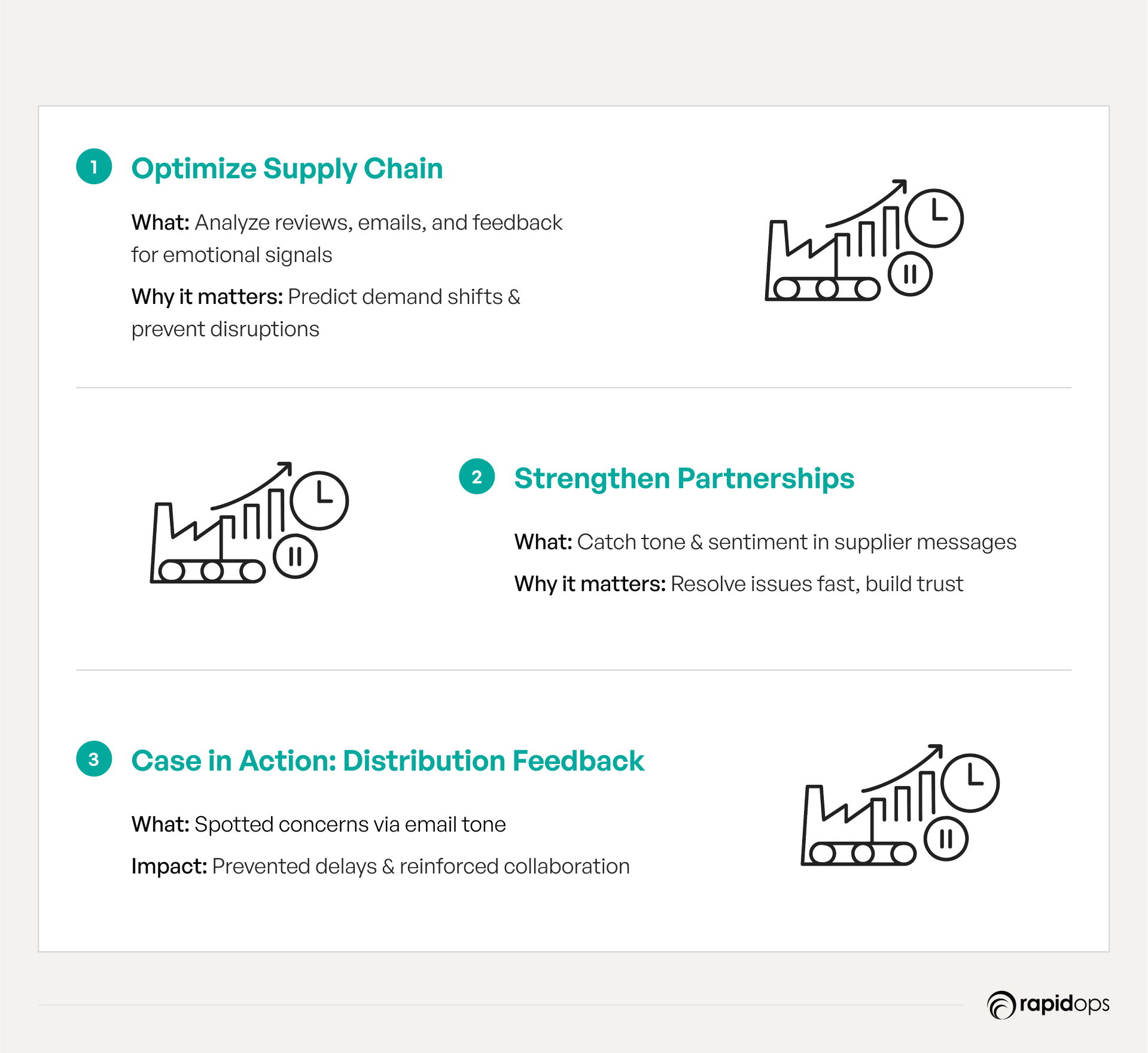
AI emotion recognition offers a window into the sentiment of both customers and suppliers, facilitating more agile decision-making in logistics and operations.
- Supply chain optimization: By analyzing sentiment from customer reviews, supplier communications, and social media, businesses can detect shifts in demand or potential disruptions before they escalate.
- Strengthening partnerships: Understanding the emotional undertones in communication with suppliers and logistics partners helps in identifying and resolving issues faster, fostering more resilient relationships.
Imagine a distribution company that uses AI-powered sentiment analysis to monitor real-time feedback across various channels.
When a regional supplier expressed concerns—subtly conveyed through tone in emails and feedback forms—the company was able to address the issue promptly, ensuring that supply chain disruptions were minimized.
This practical application of emotion AI not only safeguards operations but also builds stronger, more responsive partnerships.
The ROI of emotion recognition AI for business owners
Emotion recognition technology isn’t just a flashy innovation—it’s a strategic investment that delivers real, measurable returns.
By decoding the subtle signals behind customer smiles or worker fatigue, businesses in retail, manufacturing, and distribution are turning emotional insights into competitive advantages.
1. Better customer retention in retail
Imagine a retail space that adapts in real time to the emotions of its shoppers. With AI facial emotion recognition, retailers can dynamically adjust store displays, background music, and promotional offers based on live customer sentiment.
One major retail chain, for example, used real-time sentiment data to identify and address moments of customer frustration. This proactive approach boosted customer retention by 15–20%, proving that when customers feel truly understood, loyalty and repeat business follow naturally.
2. Increased productivity in manufacturing
In manufacturing, the human element is critical to maintaining efficiency and safety. By employing machine learning emotion detection, companies can monitor worker stress, fatigue, and overall engagement on the production floor.
Consider an automotive manufacturer that integrated emotion recognition tools to detect early signs of worker fatigue.
By introducing timely micro-breaks and targeted support, they achieved a 10–12% improvement in productivity along with a notable reduction in errors.
This example demonstrates that when employee well-being is prioritized through emotional insights, both safety and operational performance benefit.
3. Smarter logistics in distribution
For distribution businesses, efficiency and robust partner relationships are key. Sentiment analysis AI allows companies to gather insights from customer feedback and supplier communications across multiple channels.
One distribution firm, for instance, analyzed real-time sentiment data to anticipate market demand shifts and address potential supply chain issues before they escalated.
This agile approach led to optimized delivery schedules, improved inventory management, and significant cost savings—showcasing how emotional data can drive smarter, more responsive logistics.
By transforming raw emotional cues into actionable intelligence, emotion recognition AI provides a clear return on investment.
Whether it’s boosting customer loyalty, enhancing workforce productivity, or streamlining supply chain operations, this technology turns nuanced human emotion into a powerful strategic asset.
The ethical side: Where do we draw the line?
With all the promise that AI emotion recognition holds, it also raises critical questions about privacy, consent, and potential bias.
Capturing and interpreting emotions can be extraordinarily powerful, but it must be handled responsibly. Businesses venturing into this space should prioritize ethical considerations as much as they do technological innovation.
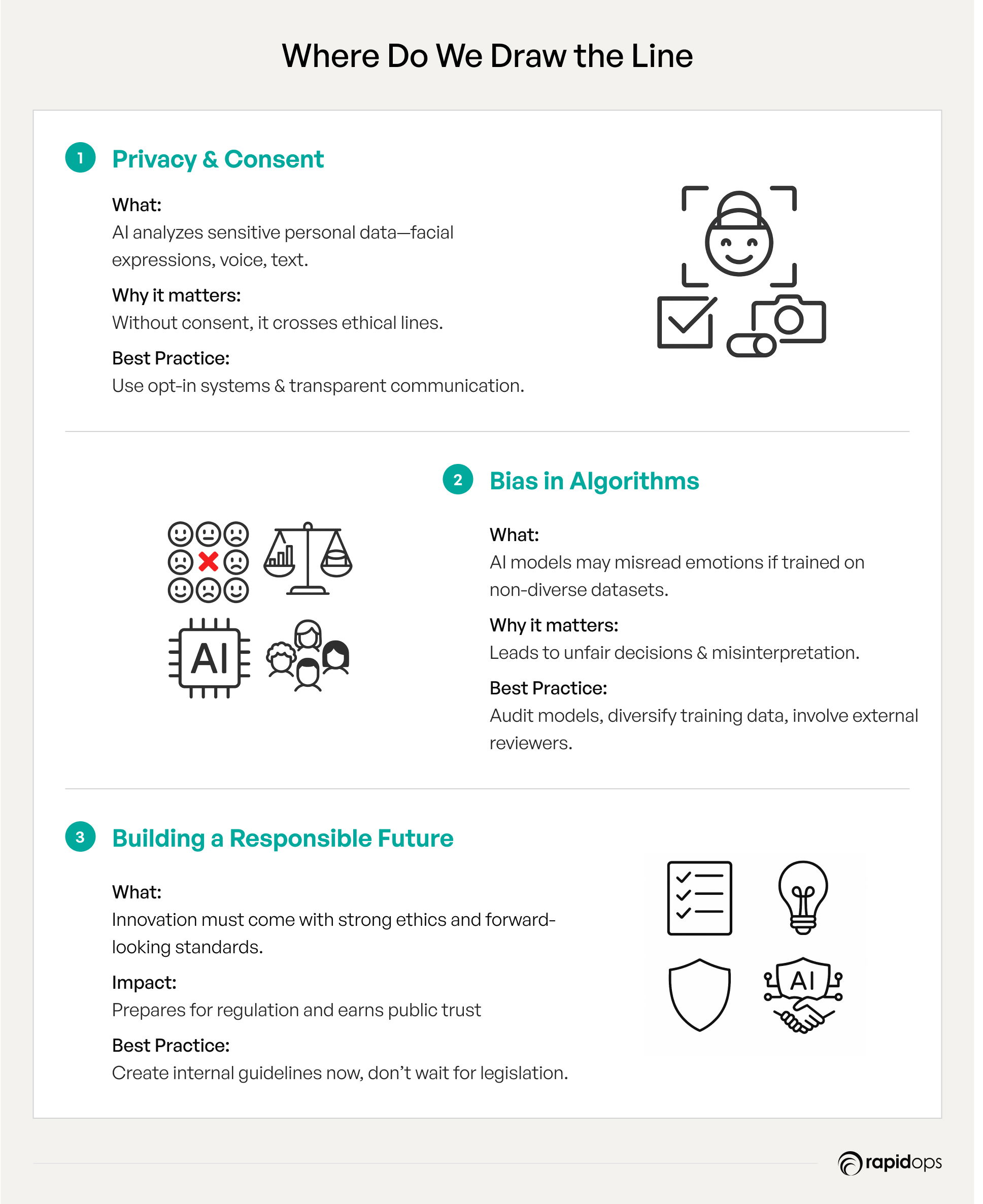 1. Privacy and consent
1. Privacy and consent
At its core, emotion recognition involves analyzing personal cues—facial expressions, vocal nuances, and text interactions.
These elements are inherently sensitive, and harvesting them without explicit permission can quickly cross ethical boundaries. Companies need transparent policies and consent-driven data collection methods that clearly explain how emotional data is gathered, stored, and used.
One approach is to integrate opt-in systems that allow individuals to decide whether they want their emotional cues analyzed.
In a retail setting, for instance, stores can inform customers about the presence of cameras and provide clear instructions for opting out. Such transparency can boost consumer trust and reduce privacy concerns.
2. The risk of algorithmic bias
Emotion recognition tools rely on datasets that train and refine machine learning models. If these datasets lack diversity—be it in terms of age, ethnicity, or cultural context—the resulting models can misinterpret or mislabel certain expressions.
This misinterpretation can have serious consequences, from skewed marketing insights to unfair employee evaluations in manufacturing or distribution settings.
To mitigate bias, businesses must continually audit their systems, ensuring that machine learning emotion detection models are exposed to a broad range of expressions and cultural contexts. Some organizations conduct ongoing bias testing and refinement, bringing in external experts to regularly review the model’s outputs.
3. Forging a responsible path forward
Ultimately, striking the right balance between innovation and ethical integrity involves clear guidelines and proactive oversight. Regulations are still evolving in this space, making it essential for businesses to set high internal standards that anticipate future legislation.
By addressing privacy, consent, and bias up front, companies can harness the full potential of emotion recognition technology while respecting the very people they aim to serve.
The future of AI emotion recognition in retail, manufacturing & distribution
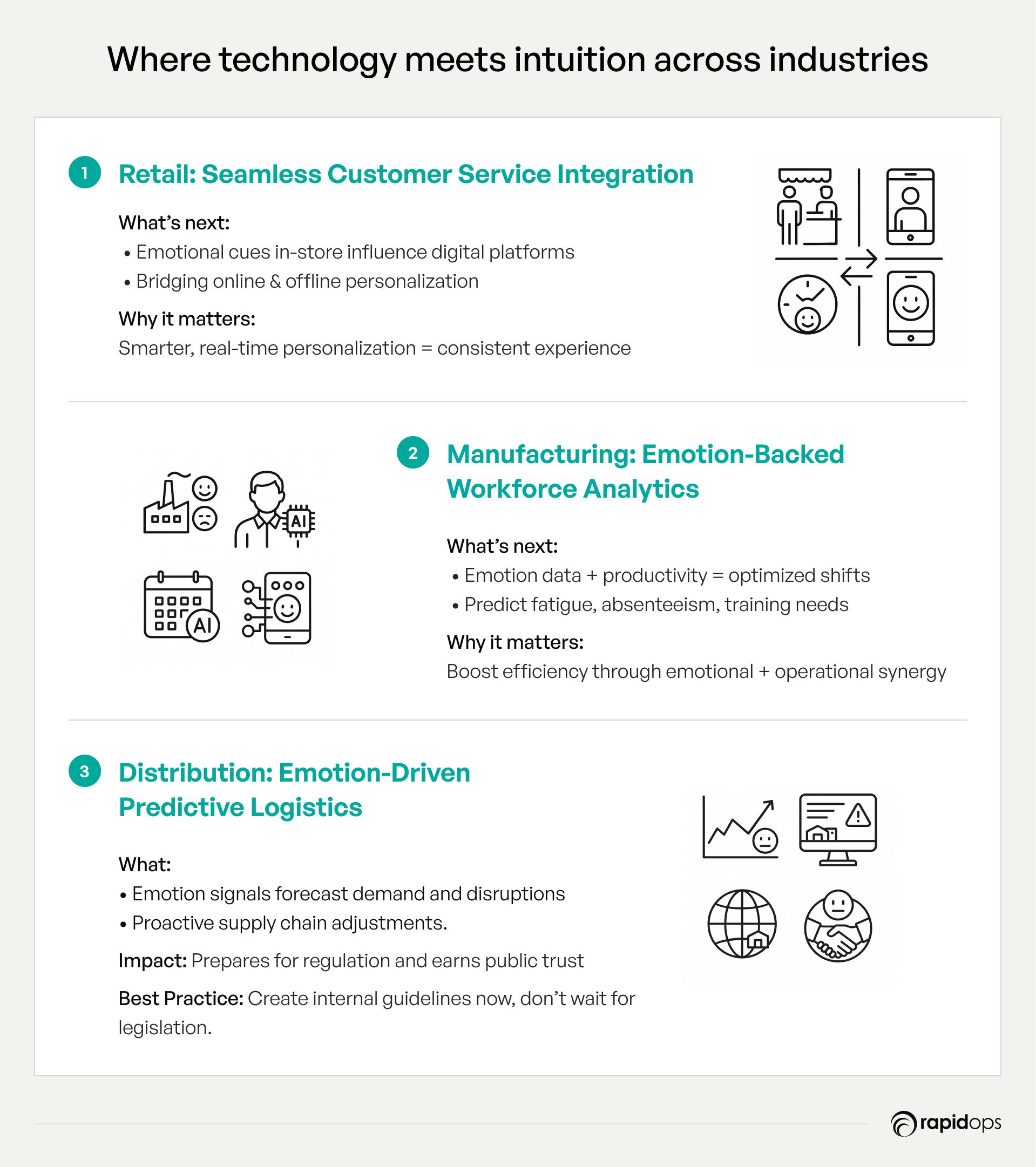
As AI emotion recognition matures, its potential to revolutionize core business processes will only grow.
While some might view this technology primarily as a tool for customer engagement, its applications are rapidly expanding to include deeper workforce analytics, real-time supply chain management, and advanced operational forecasting.
1. Deeper integration into customer service
In the retail sector, we’re already seeing AI-powered sentiment analysis used to tailor promotions and store layouts. However, the next wave of innovation will likely involve seamless integration across online and offline touchpoints. Imagine a scenario where a customer’s emotional cues in a store inform an online platform to refine product recommendations—bridging data silos and ensuring consistently personalized experiences.
2. Advanced workforce analytics in manufacturing
Manufacturing environments will continue to leverage machine learning emotion detection for real-time assessments of team morale and fatigue levels.
Over time, these insights can be integrated into broader workforce management systems to predict absenteeism, optimize shift schedules, and even inform long-term training programs. By combining emotional data with productivity metrics, factories of the future can achieve unprecedented efficiency.
3. Predictive logistics in distribution
In distribution, AI-driven customer insights are moving beyond mere sentiment monitoring to predictive analytics. By analyzing large volumes of emotional data—such as social media sentiment or partner feedback—companies can forecast surges in demand or pinpoint potential supply chain bottlenecks before they escalate. This proactive approach reduces delays, trims costs, and ultimately helps maintain smoother operations.
A powerful blend of emotion and technology
Looking ahead, the line between human intuition and data-driven decision-making will continue to blur. As emotional analytics tools become more sophisticated, businesses will gain richer, more nuanced views of their stakeholders—be they customers, employees, or supply chain partners. This synergy between emotion and technology is poised to redefine how companies strategize, innovate, and engage in their respective markets.
Conclusion: Why businesses need to take AI emotion recognition seriously
As technology continues to evolve, the ability to interpret and respond to human emotion in real time is rapidly becoming a game-changer. For forward-thinking organizations, AI emotion recognition offers more than just a novel feature—it’s a gateway to profound strategic advantage.
From boosting retail sales through hyper-personalized customer interactions to enhancing workplace safety and productivity in manufacturing, and even streamlining supply chain operations in distribution, the use cases speak for themselves.
Emotion data, when responsibly gathered and accurately analyzed, provides a richer understanding of the people behind every transaction and workflow. Instead of relying solely on traditional metrics, business owners gain an extra layer of insight that can inform decision-making at every level.
By integrating emotional intelligence into their strategic planning, companies not only make more informed choices but also foster stronger connections with customers, employees, and partners.
Yet, with this immense potential comes a responsibility to handle sensitive data ethically.
Ensuring transparent data practices and actively mitigating algorithmic bias are crucial steps in building trust and maintaining long-term viability.
By striking the right balance between innovation and integrity, businesses can transform emotion recognition from a cutting-edge concept into a sustainable, impactful tool.
In a world where competition is fierce and consumer expectations are constantly evolving, investing in emotion recognition technology isn’t just about staying on top of trends. It’s about future-proofing operations in an ever-changing marketplace and acknowledging the fundamental truth that emotions drive business outcomes.
At Rapidops Inc., our team of AI architects can guide you in discovering how AI emotion recognition can be integrated into your retail, manufacturing, or distribution workflows. Ready to transform your operations and drive measurable results?
Contact us today and let’s chart the path to your AI-powered future.

Saptarshi Das
Content Editor
9+ years of expertise in content marketing, SEO, and SERP research. Creates informative, engaging content to achieve marketing goals. Empathetic approach and deep understanding of target audience needs. Expert in SEO optimization for maximum visibility. Your ideal content marketing strategist.
What’s Inside
- What is AI emotion recognition and how does it work?
- A practical glimpse into the technology
- The ROI of emotion recognition AI for business owners
- The ethical side: Where do we draw the line?
- The future of AI emotion recognition in retail, manufacturing & distribution
- Conclusion: Why businesses need to take AI emotion recognition seriously

Let’s build the next big thing!
Share your ideas and vision with us to explore your digital opportunities
Similar Stories
- AI
- 4 Mins
- September 2022

- AI
- 9 Mins
- January 2023


Receive articles like this in your mailbox
Sign up to get weekly insights & inspiration in your inbox.

